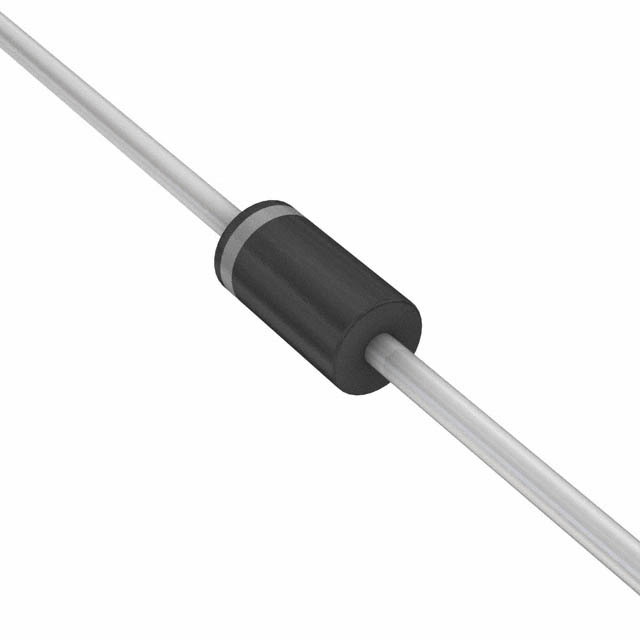Lihat spesifikasi untuk detail produk.

P4KE43AHA0G Encyclopedia Entry
Product Overview
Category
P4KE43AHA0G belongs to the category of transient voltage suppressor diodes.
Use
These diodes are used to protect sensitive electronic components from voltage spikes and transients.
Characteristics
- Package: DO-41
- Essence: Silicon transient voltage suppressor
- Packaging/Quantity: Available in tape and reel packaging, with quantities varying based on supplier.
Specifications
- Peak Pulse Power: 400W
- Breakdown Voltage Range: 36.8V to 40.6V
- Maximum Clamping Voltage: 58.1V
- Operating Temperature Range: -55°C to +175°C
Detailed Pin Configuration
The P4KE43AHA0G diode has a standard axial lead configuration with two leads.
Functional Features
- Provides protection against voltage surges and transients.
- Fast response time to clamp excessive voltage levels.
- Low leakage current for minimal power dissipation.
Advantages
- High peak pulse power handling capability.
- Wide operating temperature range.
- Compact DO-41 package for easy integration into circuit designs.
Disadvantages
- Limited breakdown voltage options within the specified range.
- May require additional circuitry for comprehensive surge protection in high-power applications.
Working Principles
When a voltage surge occurs, the P4KE43AHA0G diode conducts and clamps the excessive voltage, diverting the transient energy away from the protected circuitry.
Detailed Application Field Plans
- Consumer electronics: Protecting sensitive microelectronics in smartphones, tablets, and laptops.
- Industrial equipment: Safeguarding control systems and sensors in industrial machinery.
- Automotive electronics: Shielding vehicle electronic systems from voltage transients.
Detailed and Complete Alternative Models
- P4KE6.8A: Lower breakdown voltage option for more sensitive applications.
- P4KE100A: Higher breakdown voltage option for increased surge protection.
In conclusion, the P4KE43AHA0G transient voltage suppressor diode offers reliable protection against voltage surges and transients in various electronic applications, with its compact package and high peak pulse power making it a versatile choice for circuit protection.
Word Count: 298
Sebutkan 10 pertanyaan dan jawaban umum terkait penerapan P4KE43AHA0G dalam solusi teknis
What is P4KE43AHA0G?
- P4KE43AHA0G is a type of transient voltage suppressor diode, commonly used to protect electronic circuits from voltage spikes and transients.
What is the maximum voltage rating for P4KE43AHA0G?
- The maximum voltage rating for P4KE43AHA0G is 43V.
What is the peak pulse power handling capability of P4KE43AHA0G?
- P4KE43AHA0G has a peak pulse power handling capability of typically 400W at 10/1000μs.
In what applications can P4KE43AHA0G be used?
- P4KE43AHA0G can be used in various technical solutions such as power supplies, automotive electronics, industrial equipment, and telecommunications systems to protect against voltage surges.
What is the breakdown voltage of P4KE43AHA0G?
- The breakdown voltage of P4KE43AHA0G is 48.1V to 53.3V.
What is the operating temperature range for P4KE43AHA0G?
- P4KE43AHA0G has an operating temperature range of -55°C to +175°C.
How does P4KE43AHA0G provide protection in electronic circuits?
- P4KE43AHA0G clamps the voltage across the circuit when a transient event occurs, diverting excess current away from sensitive components.
Is P4KE43AHA0G RoHS compliant?
- Yes, P4KE43AHA0G is RoHS compliant, meaning it meets the Restriction of Hazardous Substances directive.
What are the package options available for P4KE43AHA0G?
- P4KE43AHA0G is available in various package options including DO-41, SMA, SMB, SMC, and more.
Where can I find detailed specifications and application notes for P4KE43AHA0G?
- Detailed specifications and application notes for P4KE43AHA0G can be found on the manufacturer's datasheet or website, or by contacting the manufacturer directly.

